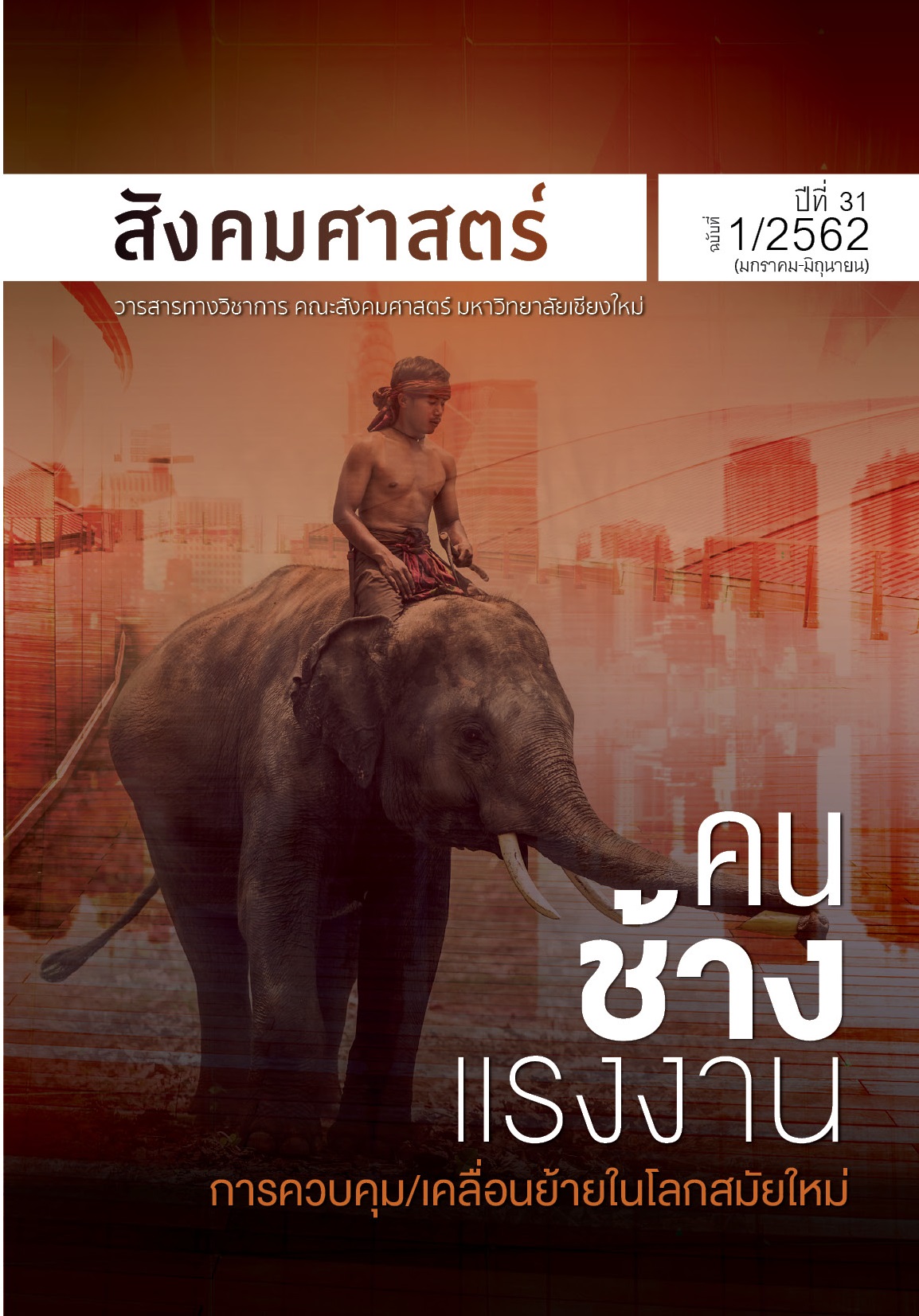Trans-space/cultural Network of the Mahouts under the Thailand’s Tourism Industry Context
Main Article Content
Abstract
This article aims to study that how under the context of Thailand's tourism industry which elephants are used as tourism’s products related to the mahout’s trans-space/cultural network. The study used the data from the Socio-economic profile of Thai mahouts in Thai tourism industry research project. The samples were the Burmese mahouts and the Kouy mahout’s network in Chonburi province.
The study indicated that the tourism industry of Thailand with came with the modernity has created a new network of mahouts that are different from the traditional mahout network. In the tradition period, the mahout network will be a network of local mahouts. It is a “closed network” within the group such as a clan or an ethnic group. However, the new generation of mahouts or postmodern networks is an “opened network” that is not limited to the local level among the clan or ethnic group. It is the trans-space / cross-cultural network, it is open to foreign mahout groups also. The new mahout groups while inherited from the traditional mahout ancestors became a group of people who had the life as nomad people in the modern world by abandoned their homeland go to the route of the elephant camp business in the tourist cities, to survive their life along with protecting the mahout identity.
Article Details
All written articles published on Journal of Social Sciences is its author’s opinion which is not belonged to Faculty of Social Sciences, Chiang Mai University or is not in a responsibility of the journal’s editorial committee’s members.
References
Rita Ringis, Elephants of Thailand in the Myth, Art, and Reality. New York: Oxford University Press, 1996.
กรมศิลปากร. พระคเณศ ของเสถียรโกเศศและนาคะประทีป และเรื่องพระคเณศที่เกี่ยวกับช้าง ของอายัณโฆษณ์. พิมพ์ครั้งที่ 3. กรุงเทพฯ: สำนักวรรณกรรมและประวัติศาสตร์ กรมศิลปากร, 2548.
กังสดาล กนกหงส์, “การศึกษาสถานภาพควาญและช้างเลี้ยง: ศึกษาเฉพาะกรณีควาญและช้างเลี้ยงที่เป็นสมาชิกของมูลนิธิช้างแห่งประเทศไทย” วิทยานิพนธ์ศิลปศาสตรมหาบัณฑิต สาขาวิชาพัฒนาชนบทศึกษา บัณฑิตวิทยาลัย มหาวิทยาลัยมหิดล, 2544.
โครงการสืบสานมรดกไทย, ช้างราชพาหนะ. กรุงเทพฯ: สตาร์ปริ้นท์ จำกัด, 2542.
ทองใบ ศรีสมบัติ. การเปลี่ยนแปลงวัฒนธรรมการเลี้ยงช้างและการประกอบอาชีพเลี้ยงช้างของหมู่บ้านช้างจังหวัดสุรินทร์. วิทยานิพนธ์ศิลปศาสตรมหาบัณฑิต สาขาไทยคดีศึกษา บัณฑิตวิทยาลัย มหาวิทยาลัยมหาสารคาม, 2535.
นิตยสารสารอนุสาร อ.ส.ท., ลัดดาแลนด์. ปีที่ 11 ฉบับที่ 4 (พฤศจิกายน 2513) หน้า 75.
เน (Nay) ควาญช้างสัญชาติพม่าจากเมาะลำไย วัย 36 ปี (สัมภาษณ์, 6 ธันวาคม 2560)
เภา บุญเยี่ยม และ ภารดี มหาขันธ์, “ปะคำ: วิถีชีวิตและการดำรงอยู่ของคนเลี้ยงช้างภายใต้พลวัตการเปลี่ยนแปลงทางสังคมและวัฒนธรรม” ใน วารสารวิชาการมนุษยศาสตร์และสังคมศาสตร์ ปีที่ 23 ฉบับที่ 41 (มกราคม-เมษายน 2558) หน้า 91-111.
รักษพล สกุลวัฒนา. คนเลี้ยงช้างชาวไทยกวยจังหวัดสุรินทร์. วิทยานิพนธ์สังคมวิทยาและมานุษยวิทยามหาบัณฑิต สาขามานุษยวิทยา มหาวิทยาลัยธรรมศาสตร์, 2538.
รุจิพันธ์ ดอกงา, “การคล้องช้างของชนเผ่าส่วย” วิทยานิพนธ์ศิลปศาสตรบัณฑิต (โบราณคดี). คณะโบราณคดี มหาวิทยาลัยศิลปากร, 2512.
สมหมาย ชินนาค, “ผีปะกำ: คติความเชื่อเรื่องผีบรรพบุรุษของชาวไทย-กวย (ส่วย) เลี้ยงช้าง จังหวัดสุรินทร์” วิทยานิพนธ์มานุษยวิทยามหาบัณฑิต. ภาควิชาสังคมวิทยาและมานุษยวิทยา บัณฑิตวิทยาลัย จุฬาลงกรณ์มหาวิทยาลัย, 2539.
สยาม อรุณศรีมรกต “วิถีชีวิตของควาญและช้างเร่ร่อนในเมือง” ใน Journal of Community Development Research 2010; 3(1) : 85-98.
สีมา สมานมิตร “ทุ่ง ป่า และภู เพื่อล่าโพนช้างของสมเด็จพระนารายณ์” ใน ศิลปวัฒนธรรม (กุมภาพันธ์ 2548) อ้างใน https://www.silpa-mag.com/history/article_10553 (เข้าถึงข้อมูลเมื่อ 5 เมษายน 2562)


